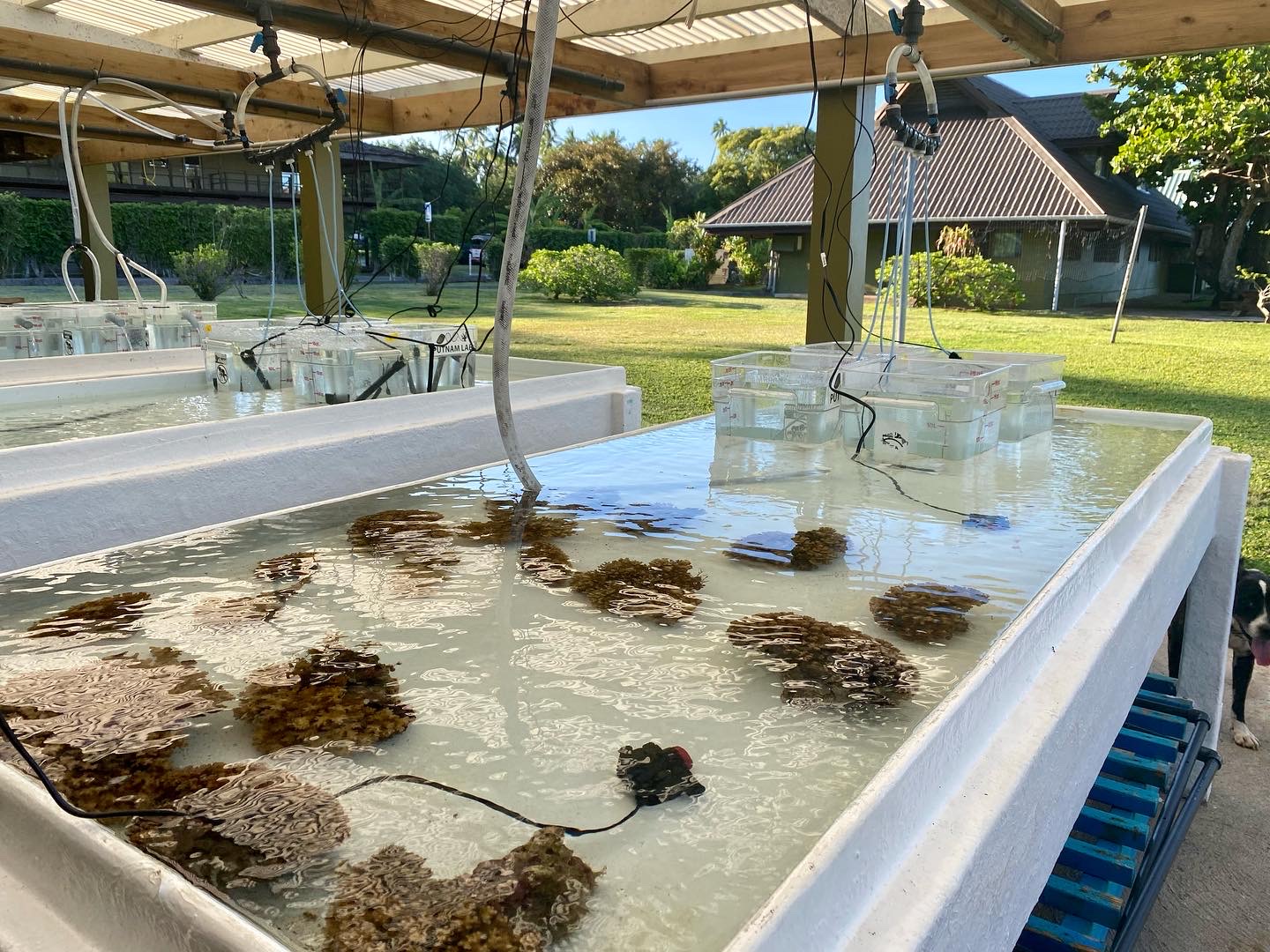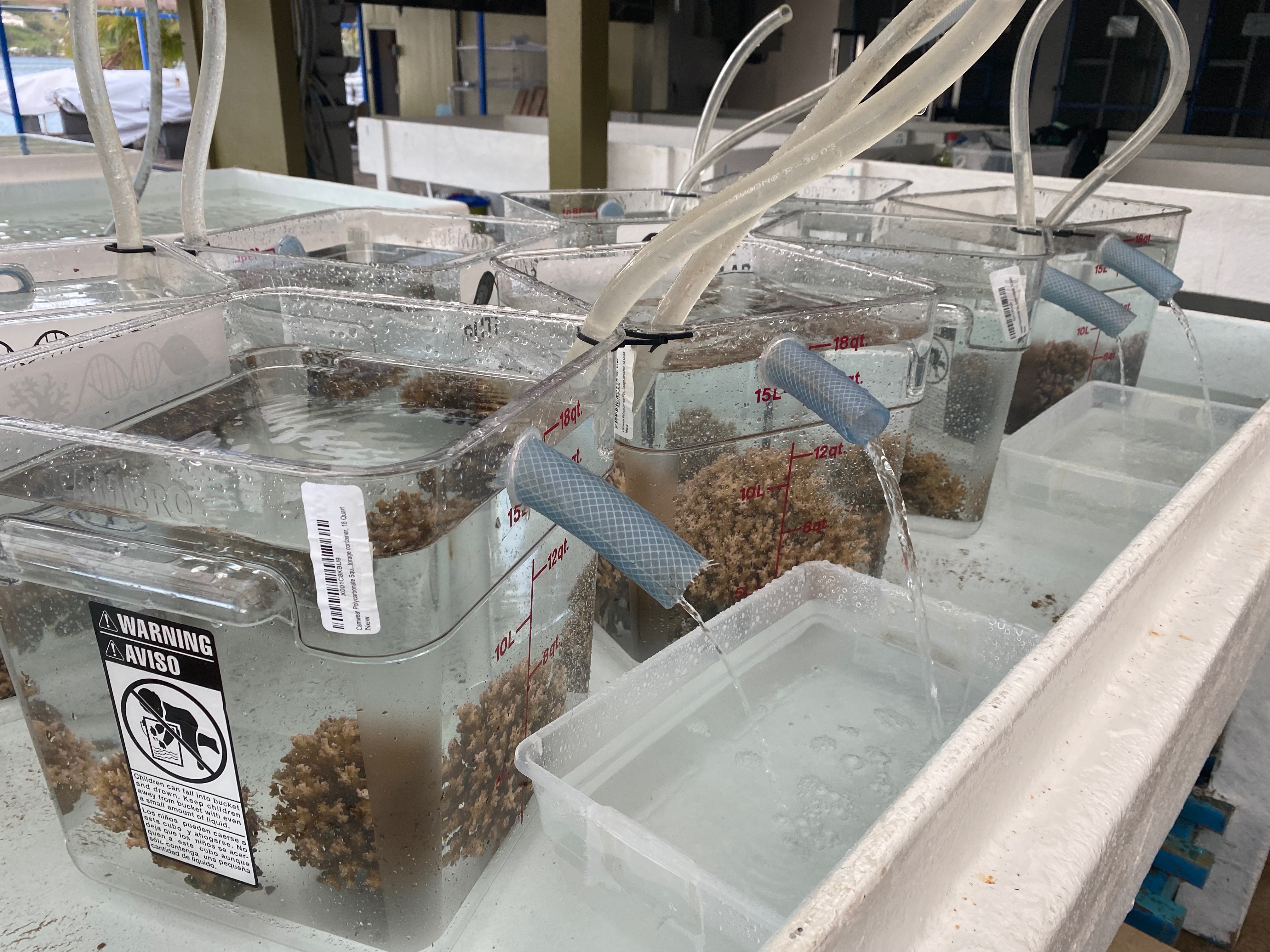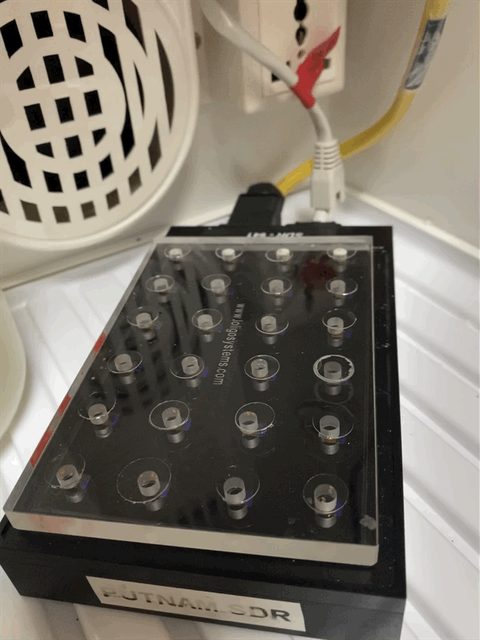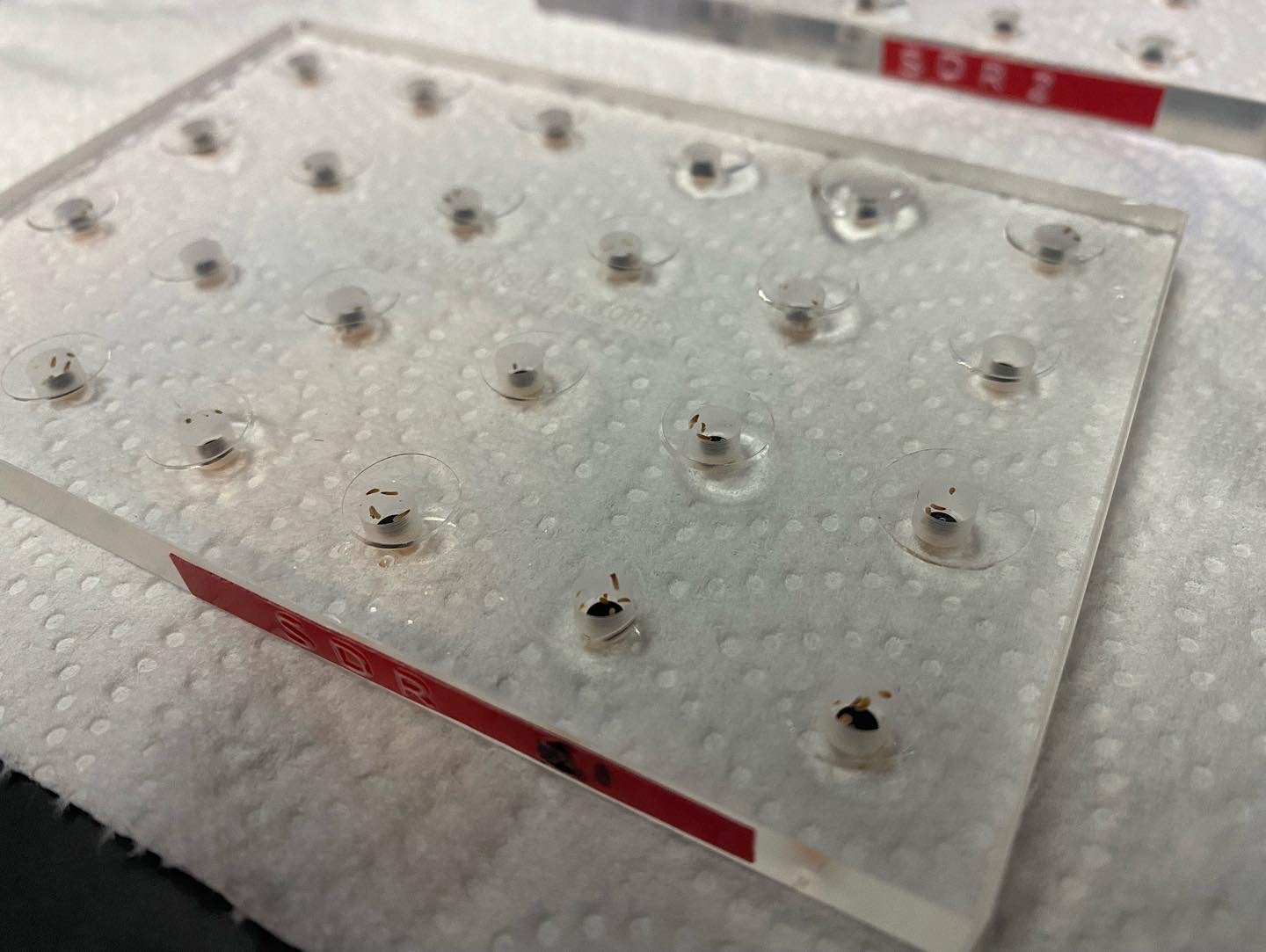Pocillopora acuta Symbiont Integration Moorea December 2021
This post details all activities in Moorea in December 2021 for Symbiont Integration project for the study species Pocillopora acuta.
Overview
We conducted a field trip in Moorea in December 2021 with the goal to sample early life stages of Acropora spp to replicate Hawaii 2021 work with Montipora capitata. However, due to loss of samples and low reproduction, we were not able to use Acropora for this study. Rather, we utilized sampling of planula larvae released over a 2-week period from Pocillopora acuta colonies. We collected samples, measured respirometry, and conducted stable isotope incubations during this 2-week period at ambient and high temperatures.
3 December 2021
In Moorea, P. acuta releases larvae ~5 days after the new moon. We collected 12 colonies from the fringe reef near the pharmacy. During this collection we collected no more than 3 colonies from a single “patch” and collected these from >5 m apart. We collected at 4 patches that were 20-50 m apart from each other. Colonies were collected and kept in coolers on the boat for transport back to UCB Gump Research Station.
Colonies were kept in a flow through seawater table at Gump.

We constructed n=8 squaricals as described for Hawaii 2021 work. We programmed Apex systems for high temperature treatments in n=4 squaricals and ambient temperature in n=4 squarials. In high temperature, apex systems were programmed to increase temperatures by ~1.5-2°C with 1-1.5°C daily flux in both ambient and high. 1 heater added to each squarical to control temperature with moderate-high unfiltered seawater flow through tubing.
Light measurements were colelcted with the APogee light meter and temperature Hobo loggers n=8 were launched. Ambient temperatures ranged from 28-30°C and high temperatures ranged from 29.5-31°C.
We also constructed squaricals for larval collection by attaching a tube that emptied into mesh sided containers for larval collection each evening.

Each evening, n=1-3 colonies were added to each container and checked the following morning for larvae.
4 December 2021
Larval collection
We checked for larvae at 0600. n=3-5 colonies released larvae for ~2,000 larvae. Larvae transferred to collection cups and put in water table until used for analysis. This proceedure was followed each day of collection. Each day, there were 3-6 colonies that released to make the larval pool.
Sampling
We collected the following responses throughout the 2-week experimental period:
- Thermal performance curves (ranging from 8-40°C)
- Photosynthesis and respiration rates (27 and 31°C)
- Stable isotope incubations (27 and 31°C)
- Freeze physiology samples
Our goal was to collect these responses before and after exposure to high temperature. However, we did not have enough larvae to do larval thermal treatments. Instead, we collected these measurements on ambient collected larvae and conducted incubations at ambient and high temperatures.
This allows us to examine performance and metabolic function in larvae exposed to elevated temperature.
Respirometry
We used respirometry to start measurements of thermal performance curves (TPC). We ran a test of P and R with 5 larvae per well. See respirometry protocol here. Temperature in incubators needed to be monitored due to higher temperature from lighting. Started test using 10% intensity on aquarium lights to avoid temperature increasing due to lighting.
We measured sufficient signals for P and R for 5 larvae per well over ~20 minutes per phase. Blanks within expected range. Zero blanks (seawater with 0% oxygen due to sodium sulfite addition) also as expected.
We ran 1 plate per temperature with n=20 wells of larvae, n=3 blanks, n=1 zero. We later stopped using the zero blanks since we confirmed that the equipment worked as expected and to avoid any contamination of sodium sulfite.
Used temperature probe to monitor temperature of incubations.
Ran dark respiration for TPC (to avoid light enhanced respiration) for 20, 22, 28, 30, 32°C. Will run more temperatures on other dates.


Freezing samples
Counted pools of 50 larvae per tube into n=18 tubes, which can be used for cell density, ash free dry weight, DNA, or others. Water removed with pipettes and flash frozen at 1900.
Environmental monitoring
Collected light measurements in squaricals and adult larval collection tables in outdoor facility.
Light averge across all tanks was ~250 PAR at 1100.
Programmed apex for squaricals:
- Ambient = 27.3-28.8°C daily (not programmed, natural profile)
- High = 29.3-30.8°C daily
Parental exposure
Added parental colonies to high temperature bins to allow for larval developmental pre exposure to elevated temperature. Added in the evening (~1800).
5 December 2021
Respirometry
Measured light fields in incubator across respirometry plate. At 10%, lights were an average of ~120 PAR. At 20%, light intensity was average ~215 PAR. However, P signals were weak at these light levels, so lights were increased to 30% as in Hawaii work and temperature was modulated with incubator controls as necessary. Average intensity at 30% was ~300-325 PAR at the level of the incubator plate. Plates were put on the bottom of the incubator.
Environmental measurements
Measured light in outdoor bins at 1145 with Apogee light sensor. Average light = 550 PAR.
Larval exposures
Placed 800 larvae in individual plastic containers with mesh sides in one ambient and one high squarical. However, we did not get enough larvae in future samplings to use these exposures for experimental purposes, so these larvae were a trial for keeping in squaricals.
Respirometry
We ran 1 plate of P and R at 27 and 30°C at 1200-1300 with 5 larvae per well
Isotopes
We conducted stable isotope incubations for stable isotope metabolomics using the same protocol as detailed for Hawaii 2021 work. Ran at 27 and 31°C.
Made 4mM solutions of the following:
C13 bicarbonate in seawater = 280mL of 1um FSW + 108 mg C13 bicarbonate
C12 bicarbonate in seawater (serves as chemistry control) = 240 mL 1uM FSW + 100 mg C12 bicarbonate
1um FSW with no label as seawater controls that can be used for other molecular assays
Set up vials with incubation treatments for each temperature treatment (27C, 31C). In each temperature treatment:
n=3 C12 n=3 C13 n=1 dark C13 n=3 no added bicarbonate
Counted 50 larvae into each vial. Used 20 total vials (n=10 per temperature) with 20 mL volume. Tops not sealed, vials swirled about every hour. Checked pH of solutions with pH indicator strips.
Incubated for 5 hours.
After incubation, froze samples by rinsing 3x in filtered seawater and removing water from tube in a pipette before flash freezing.

6 December 2021
Respiration
Ran 2 rounds of P and R plates with newly collected larvae from 0800-1200 at 27 and 31°C.
Isotopes
Ran another round of isotope incubations as described for 5 December 2021 and incubated for 5 hours at 27 and 31°C.
7 December 2021
Respiration
Ran 2 rounds of P and R at 27 and 34°C to obtain a higher temperature.
Isotopes
Conducted another round of isotope incubations at 27 and 34°C. Sample size was as follows:
At 27°C: n=2 C12 n=2 C13 n=2 no added bicarbonate n=1 dark C13
At 34°C: n=4 C12 n=4 C13 n=4 no added bicarbonate n=1 dark C13
Ran for 5 hours and sampled as previously described.
8 December 2021
Respirometry
Ran a full set of thermal performance curves today. Using one day of measurements we can compare temperatures reliably together. For this, we used colonies that were exposed to high temperature for 3 days (high parental history). These “high” and “ambient” history larvae were measured across temperatures to gain thermal performance curves.
We randomly selected the order of temperatures and included both ambient and high larvae within each plate. We used dark respiration for 15-20 min runs. Larvae were dark acclimated in an indoor environment before TPC.
All plate maps and metadata for all analyses are on Google Drive.
Temperatures ran:
8°C (used ice blook to cool incubator)
18°C
22°C
24°C
26°C
28°C
30°C
32°C
34°C
36°C
38°C
40°C
All water for all respirometry was 0.2um filtered seawater.
9 December 2021
Ran n=4 C12, n=7 C13, n=1 dark C13 incubation with unknown number of larvae as extras to practice extractions for metabolomics.
Ran n=4 plates of P and R for different stages (Stage 1, 2, 3) for Alex F. work.
Alex F. also provided n=6 tubes of Acropora retusa for our use with 20-30 larvae per tube from spawning at CRIOBE. Flash frozen.
14 December 2021
All adult colonies returned to the reef and samples packed and shipped to URI in dry shippers.


